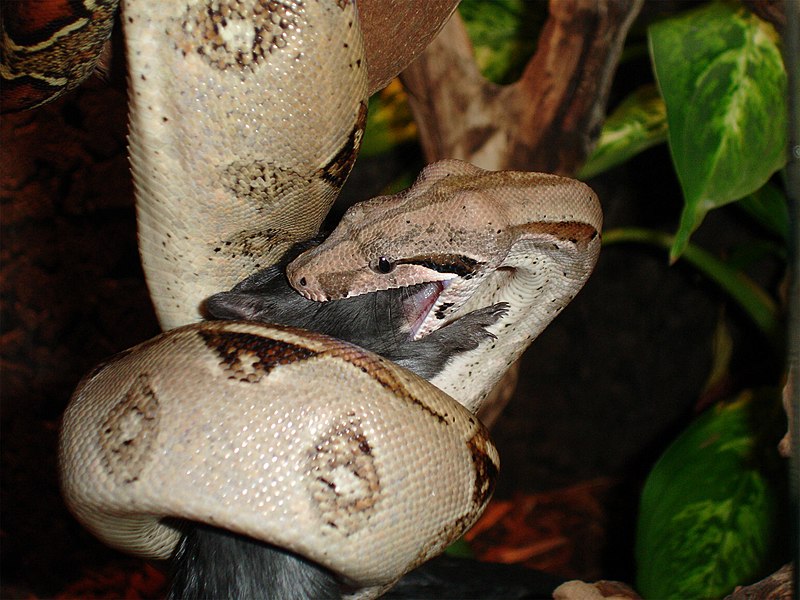 |
| Previously thought to kill their prey via suffocation, new studies reveal the real horrifying method boa constrictors use to put their prey to death! (Wikimedia Commons) |
A group of scientists from around the world decided to study how boa constrictors and their relatives, like the anacondas (yes, the anaconda is a species of boa), capture and kill their prey. It turned out that these snakes don't actually kill their prey by suffocation as has long been believed – instead, prey dies due to...blood constriction! Gosh, and I thought the boa's method of killing was nightmarish enough as everyone once thought it was! To get the full scoop on this discovery, my trusty, junior photographer, Daniel P. Smithwater, and I decided to pay a visit to one of the scientists involved in the study who actually works right here at Animal Adventures Inc.'s Animal Adventures Institute: Dr. Arizona Stevenson.
Dr. Arizona Stevenson, a personal friend of mine, is a zoologist and was surprised by the discovery they made. She's quoted for saying, “We initially wanted to study how boa constrictors attack and kill their prey, so we fed them rats and filmed them using slow-motion cameras. But we quickly noticed that the rats were dying too quickly for the cause of their death to be from suffocation.” She also explained that animals can remain alive (in an unconscious state) for longer periods of time than these rats were. “That's when one of my colleagues found a hypothesis put forward by a herpetologist in 1994 that boas don't kill their prey via suffocation, but by cardiac arrest. However, at the time the hypothesis had been ignored and untested.” So Dr. Arizona and her team decided to do just that!
They hooked up some live rats to a machine that would tell the scientists their blood pressure. When the rat was grabbed by the boa constrictor they used during the experiment, they found that indeed, the rat's blood pressure decreased as the snake tightened its coils around its body. “The boa constrictor's grip was so tight,” Dr. Arizona says, “that it cut off the rat's supply of blood to the brain, heart and other vital organs. The rats were out cold within seconds, proving the early hypothesis to be true!”
Dr. Arizona told me that this technique helps the snakes to kill prey far larger than themselves. “It takes a lot more time to suffocate a prey animal – like a capybara or a crocodile – than it does to kill it by cutting off circulation,” she said. “This is a good thing, because since the snakes lack legs, the more time they spend trying to kill their prey, the more time their prey has to potentially injure them.”
Dr. Arizona and the team are very impressed with the amount of scientific research and experimentation they've conducted over the course of the past several months. And since their work has completely debunked older “facts” about these animals, the scientists wonder what other well known animal “facts” that have been considered true for years are false.
“This discovery just goes to show us,” Dr. Arizona says, “that even when we think we know everything there is to know about something – in this case, boa constrictors – we learn that once again, scientific research is there to remind us how how little we really know.”
Written by: Mr. Smiley
Photographer: Daniel P. Smithwater
Edited by: Christian Ryan
Weekly Cartoons
Next Issue: Rerun Article: A Very Sticky Situation

Being killed quickly is less "nightmarish" than being suffocated.
ReplyDelete(obviously - but just suggesting a re-word there)